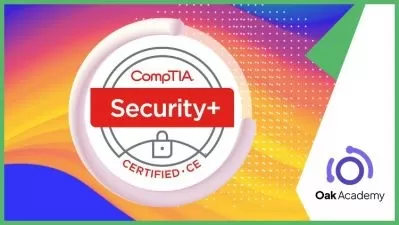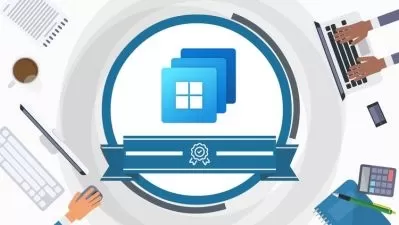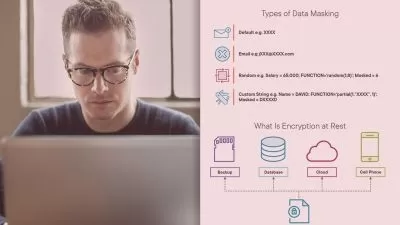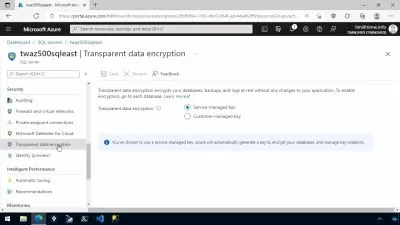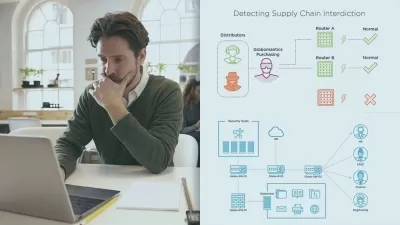CRISC -Certified in Risk and Information Systems Control '23
Nour | Cyvitrix Train
15:43:44
Description
The Complete ISACA CRISC Training - 2023 Latest as per review manual 7th edition
What You'll Learn?
- Understand the main principles of IT risk management, including identification, assessment, analysis, evaluation, and treatment.
- Learn how to conduct an effective risk assessment within an organization using various tools and techniques.
- Develop an understanding of risk mitigation strategies and how to effectively communicate risk to stakeholders and decision-makers.
- Become familiar with major IT control frameworks such as COBIT, COSO, and ISO 27001, and their application in the risk management process.
- Understand the various components of information security governance such as policies, guidelines, and procedures, and their role in managing IT risk.
- Gain knowledge of business continuity and disaster recovery planning, including the development of a disaster recovery plan and testing and maintenance.
- Learn about regulatory and legal compliance frameworks and their impact on IT risk management.
- Build practical skills in implementing IT risk management practices within an organization, including developing risk management plans and effectively communica
- Gain exam preparation tips and strategies to help successfully pass the CRISC certification exam.
Who is this for?
What You Need to Know?
More details
DescriptionWelcome to our ALL New CRISC Training
CRISC (Certified in Risk and Information Systems Control) certification is a globally recognized credential that validates experience and knowledge in the field of IT risk management. This course is designed to prepare individuals for the CRISC exam, which covers key risk management topics such as identification, assessment, evaluation, treatment, and communication.
By obtaining this certification, professionals will be equipped with the skills to help organizations effectively manage risks and protect critical information assets. Throughout the course, participants will gain a deep understanding of risk management principles, techniques, and frameworks that can be applied in various industries and organizations.
The certification is highly valued by employers, and prepares professionals for a range of high-demand careers, including IT risk management, security management, and IT auditing.
What is in this course?
1. Overview of IT Risk Management - The course will cover the main principles of IT risk management including identification, assessment, analysis, evaluation, and treatment.
2. Risk Assessment - You will learn how to conduct an effective risk assessment within an organization, utilizing various tools and techniques.
3. Risk Mitigation Strategies - The course will provide an in-depth understanding of risk mitigation strategies and how to effectively communicate risk to stakeholders and decision-makers.
4. IT Control Frameworks - The course will explore major IT control frameworks such as COBIT, COSO, and ISO 27001, and their application in the risk management process.
5. Information Security Governance - The course will cover the various components of information security governance such as policies, guidelines, and procedures, and their role in managing IT risk.
6. Business Continuity and Disaster Recovery - The course will introduce key concepts and practices within business continuity and disaster recovery planning, including the development of a disaster recovery plan and testing and maintenance.
7. Regulatory and Legal Compliance - The course will provide an overview of regulatory and legal compliance frameworks and their impact on IT risk management.
8. IT Risk Management Implementation - The course will include practical guidance on how to implement IT risk management practices within an organization, including developing risk management plans and effectively communicating risk and control measures.
9. Exam Preparation - The course will provide participants with exam preparation tips and strategies to help them successfully pass the CRISC certification exam.
To become CRISC certified, you must follow these steps:
1. Meet the eligibility requirements: To be eligible for the CRISC certification, you need to have at least three years of experience in IT risk management and information systems control.
2. Apply for the certification: You can apply for the CRISC certification through the ISACA website. You will need to provide proof of your education and experience.
3. Prepare for the exam: You can prepare for the CRISC exam by studying the official study materials provided by ISACA or by taking a CRISC certification training course.
4. Pass the exam: The CRISC exam consists of 150 questions and you must score at least 450 out of 800 to pass.
5. Complete the application for certification: After passing the exam, you will need to complete the certification application and agree to ISACA's Code of Professional Ethics.
6. Maintain the certification: To maintain your CRISC certification, you must earn 120 continuing professional education (CPE) credits every three years and pay the certification maintenance fee. Once you have completed all these steps and received your CRISC certification, you can enjoy the benefits of being a certified IT risk management and information systems control professional.
Course requirements
To enroll in this course, you should have a basic understanding of information security concepts and practices. There are no other prerequisites for this course. To enroll, simply visit the course landing page on Udemy and click on the "Enroll Now" button.
The CRISC course on Udemy is an excellent choice for anyone who wants to learn about information security principles, concepts, and practices. With comprehensive coverage of the eight domains of information security, interactive quizzes and assessments, and preparation for the CRISC certification exam, this course will help you become a skilled information security Risk Manager Professional. Enroll now and start your journey towards a successful career in information security!
Secure Your Future with Cyvitrix
In today's digital age, cybersecurity and information security are no longer optional. With an increasing amount of sensitive information being stored and shared online, the need for top-notch security has never been greater. Welcome to Cyvitrix, your ultimate resource for comprehensive and cutting-edge cybersecurity courses.
At Cyvitrix, we understand that knowledge is power — power to protect, power to prevent, and power to prosper. Our wide range of courses caters to everyone, from beginners who want to understand the basics to professionals seeking advanced skills to stay ahead of the curve.
Why Choose Cyvitrix?
Industry-Relevant Curriculum: We constantly update our courses to reflect the latest threats and trends in cybersecurity. You'll learn how to deal with real-world scenarios, preparing you for the challenges you'll face in the field.
Expert Instructors: Our courses are taught by industry veterans with years of experience in cybersecurity and information security. They're not just teachers, they're practitioners who have been in the trenches.
Flexible Learning: We believe in making learning accessible. Whether you prefer to study at your own pace online or enjoy the intensity of live online classes, we've got you covered.
Certification: Upon completion of our courses, you'll receive a Cyvitrix certification, a testament to your newfound skills and a valuable addition to your professional profile.
Community: Join a network of like-minded learners and experts. Share insights, ask questions, and build connections in our vibrant community.
Whether you're looking to advance your career, start a new one, or simply enhance your understanding of cybersecurity, Cyvitrix is your trusted partner on this journey. With our courses, you're not just investing in education; you're investing in your future.
Take the first step towards empowering your digital life. Enroll in a Cyvitrix course today.
At Cyvitrix, we provide Training courses that help you as students to conquer and pass your certification exams from first attempt.
Our courses are designed to provide you all what you need in order not only to pass the exam, but also to apply this knowledge to elevate and support your career objectives
Why training with us is ideal for you?
- Excellent quality video content
- High courses quality
- Organized materials
- Real life scenarios and examples
- Practice questions and questions ideas
- Up to date content
- Instructor is available to answer all questions you might get
- Reasonable pricing
Important Notice
THIS COURSE IS NOT OFFICIAL, NOT SPONSORED BY ISACA
Who this course is for:
- IT managers: IT managers who are responsible for managing IT operations and ensuring they are aligned with business objectives and comply with legal and regulatory requirements.
- IT professionals: IT professionals who are responsible for implementing and managing IT processes, such as IT service management, IT security, and IT risk management.
- Compliance professionals: Compliance professionals who are responsible for ensuring that the organization's IT processes comply with legal and regulatory requirements.
- Risk management professionals: Risk management professionals who are responsible for identifying and managing IT risks.
- Business analysts: Business analysts who want to understand how IT governance, security, and compliance impact their organization's business processes.
Welcome to our ALL New CRISC Training
CRISC (Certified in Risk and Information Systems Control) certification is a globally recognized credential that validates experience and knowledge in the field of IT risk management. This course is designed to prepare individuals for the CRISC exam, which covers key risk management topics such as identification, assessment, evaluation, treatment, and communication.
By obtaining this certification, professionals will be equipped with the skills to help organizations effectively manage risks and protect critical information assets. Throughout the course, participants will gain a deep understanding of risk management principles, techniques, and frameworks that can be applied in various industries and organizations.
The certification is highly valued by employers, and prepares professionals for a range of high-demand careers, including IT risk management, security management, and IT auditing.
What is in this course?
1. Overview of IT Risk Management - The course will cover the main principles of IT risk management including identification, assessment, analysis, evaluation, and treatment.
2. Risk Assessment - You will learn how to conduct an effective risk assessment within an organization, utilizing various tools and techniques.
3. Risk Mitigation Strategies - The course will provide an in-depth understanding of risk mitigation strategies and how to effectively communicate risk to stakeholders and decision-makers.
4. IT Control Frameworks - The course will explore major IT control frameworks such as COBIT, COSO, and ISO 27001, and their application in the risk management process.
5. Information Security Governance - The course will cover the various components of information security governance such as policies, guidelines, and procedures, and their role in managing IT risk.
6. Business Continuity and Disaster Recovery - The course will introduce key concepts and practices within business continuity and disaster recovery planning, including the development of a disaster recovery plan and testing and maintenance.
7. Regulatory and Legal Compliance - The course will provide an overview of regulatory and legal compliance frameworks and their impact on IT risk management.
8. IT Risk Management Implementation - The course will include practical guidance on how to implement IT risk management practices within an organization, including developing risk management plans and effectively communicating risk and control measures.
9. Exam Preparation - The course will provide participants with exam preparation tips and strategies to help them successfully pass the CRISC certification exam.
To become CRISC certified, you must follow these steps:
1. Meet the eligibility requirements: To be eligible for the CRISC certification, you need to have at least three years of experience in IT risk management and information systems control.
2. Apply for the certification: You can apply for the CRISC certification through the ISACA website. You will need to provide proof of your education and experience.
3. Prepare for the exam: You can prepare for the CRISC exam by studying the official study materials provided by ISACA or by taking a CRISC certification training course.
4. Pass the exam: The CRISC exam consists of 150 questions and you must score at least 450 out of 800 to pass.
5. Complete the application for certification: After passing the exam, you will need to complete the certification application and agree to ISACA's Code of Professional Ethics.
6. Maintain the certification: To maintain your CRISC certification, you must earn 120 continuing professional education (CPE) credits every three years and pay the certification maintenance fee. Once you have completed all these steps and received your CRISC certification, you can enjoy the benefits of being a certified IT risk management and information systems control professional.
Course requirements
To enroll in this course, you should have a basic understanding of information security concepts and practices. There are no other prerequisites for this course. To enroll, simply visit the course landing page on Udemy and click on the "Enroll Now" button.
The CRISC course on Udemy is an excellent choice for anyone who wants to learn about information security principles, concepts, and practices. With comprehensive coverage of the eight domains of information security, interactive quizzes and assessments, and preparation for the CRISC certification exam, this course will help you become a skilled information security Risk Manager Professional. Enroll now and start your journey towards a successful career in information security!
Secure Your Future with Cyvitrix
In today's digital age, cybersecurity and information security are no longer optional. With an increasing amount of sensitive information being stored and shared online, the need for top-notch security has never been greater. Welcome to Cyvitrix, your ultimate resource for comprehensive and cutting-edge cybersecurity courses.
At Cyvitrix, we understand that knowledge is power — power to protect, power to prevent, and power to prosper. Our wide range of courses caters to everyone, from beginners who want to understand the basics to professionals seeking advanced skills to stay ahead of the curve.
Why Choose Cyvitrix?
Industry-Relevant Curriculum: We constantly update our courses to reflect the latest threats and trends in cybersecurity. You'll learn how to deal with real-world scenarios, preparing you for the challenges you'll face in the field.
Expert Instructors: Our courses are taught by industry veterans with years of experience in cybersecurity and information security. They're not just teachers, they're practitioners who have been in the trenches.
Flexible Learning: We believe in making learning accessible. Whether you prefer to study at your own pace online or enjoy the intensity of live online classes, we've got you covered.
Certification: Upon completion of our courses, you'll receive a Cyvitrix certification, a testament to your newfound skills and a valuable addition to your professional profile.
Community: Join a network of like-minded learners and experts. Share insights, ask questions, and build connections in our vibrant community.
Whether you're looking to advance your career, start a new one, or simply enhance your understanding of cybersecurity, Cyvitrix is your trusted partner on this journey. With our courses, you're not just investing in education; you're investing in your future.
Take the first step towards empowering your digital life. Enroll in a Cyvitrix course today.
At Cyvitrix, we provide Training courses that help you as students to conquer and pass your certification exams from first attempt.
Our courses are designed to provide you all what you need in order not only to pass the exam, but also to apply this knowledge to elevate and support your career objectives
Why training with us is ideal for you?
- Excellent quality video content
- High courses quality
- Organized materials
- Real life scenarios and examples
- Practice questions and questions ideas
- Up to date content
- Instructor is available to answer all questions you might get
- Reasonable pricing
Important Notice
THIS COURSE IS NOT OFFICIAL, NOT SPONSORED BY ISACA
Who this course is for:
- IT managers: IT managers who are responsible for managing IT operations and ensuring they are aligned with business objectives and comply with legal and regulatory requirements.
- IT professionals: IT professionals who are responsible for implementing and managing IT processes, such as IT service management, IT security, and IT risk management.
- Compliance professionals: Compliance professionals who are responsible for ensuring that the organization's IT processes comply with legal and regulatory requirements.
- Risk management professionals: Risk management professionals who are responsible for identifying and managing IT risks.
- Business analysts: Business analysts who want to understand how IT governance, security, and compliance impact their organization's business processes.
User Reviews
Rating
Nour | Cyvitrix Train
Instructor's Courses
Udemy
View courses Udemy- language english
- Training sessions 97
- duration 15:43:44
- Release Date 2023/10/12






